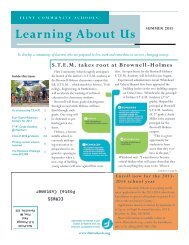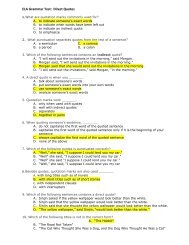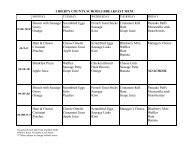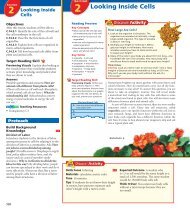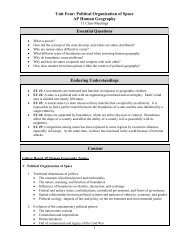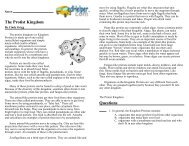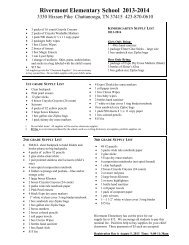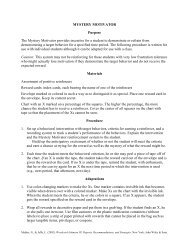The First Civilizations - Baby's First Year
The First Civilizations - Baby's First Year
The First Civilizations - Baby's First Year
You also want an ePaper? Increase the reach of your titles
YUMPU automatically turns print PDFs into web optimized ePapers that Google loves.
Copyright © by <strong>The</strong> McGraw-Hill Companies, Inc.<br />
Name Date Class<br />
READING ESSENTIALS AND STUDY GUIDE 1-1 (continued)<br />
Region Crops<br />
Asia wheat, barley, rice, soybeans, millet<br />
Africa coffee, cocoa, millet, barley, onions, wheat, flax<br />
Europe oats, rye, olives<br />
South America beans, cotton, peanuts, potatoes, peppers,<br />
coffee, cocoa<br />
North America beans, sunflowers, squash<br />
<strong>The</strong> Growth of Villages Farming allowed people to stay in one<br />
place. Herders still drove their flocks wherever they could<br />
find grazing land. Farmers, however, had to stay put.<br />
<strong>The</strong>y needed to water their plants and protect them from<br />
hungry animals. <strong>The</strong>y also had to wait to reap the harvest.<br />
So they built permanent homes and created villages.<br />
During the Neolithic Age, villages grew in Europe,<br />
India, Egypt, China, and Mexico. <strong>The</strong> earliest known communities<br />
have been found in the Middle East. One of the<br />
oldest is Jericho, which dates back to about 8000 B.C.<br />
Another well-known Neolithic community is Çatal<br />
Hüyük in present-day Turkey. This village was home to<br />
about 6,000 people between 6700 B.C. and 5700 B.C. Some<br />
of its ruins have left behind clues to how its residents<br />
lived. For example, mud-brick houses were packed<br />
tightly together. People made wall paintings. <strong>The</strong>y<br />
farmed, hunted, raised sheep and goats, worshiped<br />
together, and ate fish and bird eggs.<br />
<strong>The</strong> Benefits of a Settled Life Neolithic people had a more secure<br />
life. Steady food supplies meant healthy, growing populations.<br />
Larger populations meant more workers to produce<br />
a bigger crop. Now they had a surplus to use for trade<br />
both within and outside their communities.<br />
People made another advance in how they produced<br />
things. <strong>The</strong>y began to practice specialization, or the<br />
development of different kinds of jobs. Now, not everyone<br />
needed to farm. So some people had time to develop<br />
other types of skills. <strong>The</strong>se craftspeople made clay pottery<br />
and wove cloth. <strong>The</strong>se workers then traded what they<br />
made for goods they needed.<br />
5



